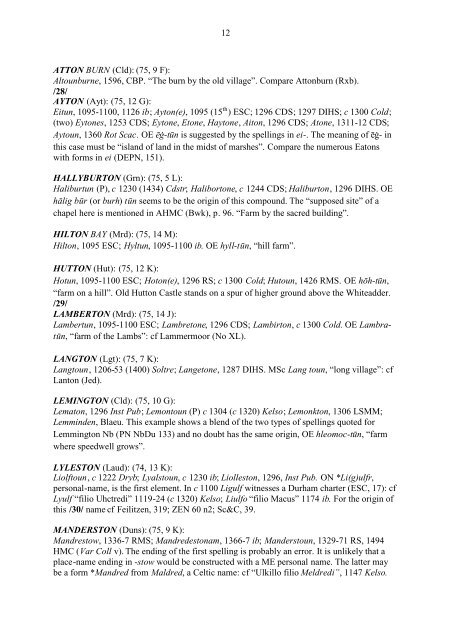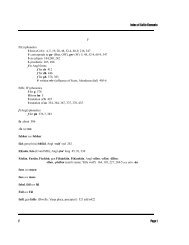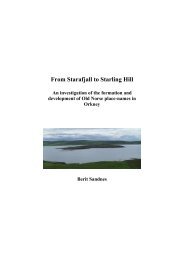May Williamson: The Non-Celtic Place-Names of the Scottish Border ...
May Williamson: The Non-Celtic Place-Names of the Scottish Border ...
May Williamson: The Non-Celtic Place-Names of the Scottish Border ...
Create successful ePaper yourself
Turn your PDF publications into a flip-book with our unique Google optimized e-Paper software.
12<br />
ATTON BURN (Cld): (75, 9 F):<br />
Altounburne, 1596, CBP. “<strong>The</strong> burn by <strong>the</strong> old village”. Compare Attonburn (Rxb).<br />
/28/<br />
AYTON (Ayt): (75, 12 G):<br />
Eitun, 1095-1100, 1126 ib; Ayton(e), 1095 (15 th ) ESC; 1296 CDS; 1297 DIHS; c 1300 Cold;<br />
(two) Eytones, 1253 CDS; Eytone, Etone, Haytone, Aiton, 1296 CDS; Atone, 1311-12 CDS;<br />
Aytoun, 1360 Rot Scac. OE -tn is suggested by <strong>the</strong> spellings in ei-. <strong>The</strong> meaning <strong>of</strong> - in<br />
this case must be “island <strong>of</strong> land in <strong>the</strong> midst <strong>of</strong> marshes”. Compare <strong>the</strong> numerous Eatons<br />
with forms in ei (DEPN, 151).<br />
HALLYBURTON (Grn): (75, 5 L):<br />
Haliburtun (P), c 1230 (1434) Cdstr; Halibortone, c 1244 CDS; Haliburton, 1296 DIHS. OE<br />
hlig br (or burh) tn seems to be <strong>the</strong> origin <strong>of</strong> this compound. <strong>The</strong> “supposed site” <strong>of</strong> a<br />
chapel here is mentioned in AHMC (Bwk), p. 96. “Farm by <strong>the</strong> sacred building”.<br />
HILTON BAY (Mrd): (75, 14 M):<br />
Hilton, 1095 ESC; Hyltun, 1095-1100 ib. OE hyll-tn, “hill farm”.<br />
HUTTON (Hut): (75, 12 K):<br />
Hotun, 1095-1100 ESC; Hoton(e), 1296 RS; c 1300 Cold; Hutoun, 1426 RMS. OE hh-tn,<br />
“farm on a hill”. Old Hutton Castle stands on a spur <strong>of</strong> higher ground above <strong>the</strong> Whiteadder.<br />
/29/<br />
LAMBERTON (Mrd): (75, 14 J):<br />
Lambertun, 1095-1100 ESC; Lambretone, 1296 CDS; Lambirton, c 1300 Cold. OE Lambratn,<br />
“farm <strong>of</strong> <strong>the</strong> Lambs”: cf Lammermoor (No XL).<br />
LANGTON (Lgt): (75, 7 K):<br />
Langtoun, 1206-53 (1400) Soltre; Langetone, 1287 DIHS. MSc Lang toun, “long village”: cf<br />
Lanton (Jed).<br />
LEMINGTON (Cld): (75, 10 G):<br />
Lematon, 1296 Inst Pub; Lemontoun (P) c 1304 (c 1320) Kelso; Lemonkton, 1306 LSMM;<br />
Lemminden, Blaeu. This example shows a blend <strong>of</strong> <strong>the</strong> two types <strong>of</strong> spellings quoted for<br />
Lemmington Nb (PN NbDu 133) and no doubt has <strong>the</strong> same origin, OE hleomoc-tn, “farm<br />
where speedwell grows”.<br />
LYLESTON (Laud): (74, 13 K):<br />
Liolftoun, c 1222 Dryb; Lyalstoun, c 1230 ib; Liolleston, 1296, Inst Pub. ON *Li(g)ulfr,<br />
personal-name, is <strong>the</strong> first element. In c 1100 Ligulf witnesses a Durham charter (ESC, 17): cf<br />
Lyulf “filio Uhctredi” 1119-24 (c 1320) Kelso; Liulfo “filio Macus” 1174 ib. For <strong>the</strong> origin <strong>of</strong><br />
this /30/ name cf Feilitzen, 319; ZEN 60 n2; Sc&C, 39.<br />
MANDERSTON (Duns): (75, 9 K):<br />
Mandrestow, 1336-7 RMS; Mandredestonam, 1366-7 ib; Manderstoun, 1329-71 RS, 1494<br />
HMC (Var Coll v). <strong>The</strong> ending <strong>of</strong> <strong>the</strong> first spelling is probably an error. It is unlikely that a<br />
place-name ending in -stow would be constructed with a ME personal name. <strong>The</strong> latter may<br />
be a form *Mandred from Maldred, a <strong>Celtic</strong> name: cf “Ulkillo filio Meldredi”, 1147 Kelso.




